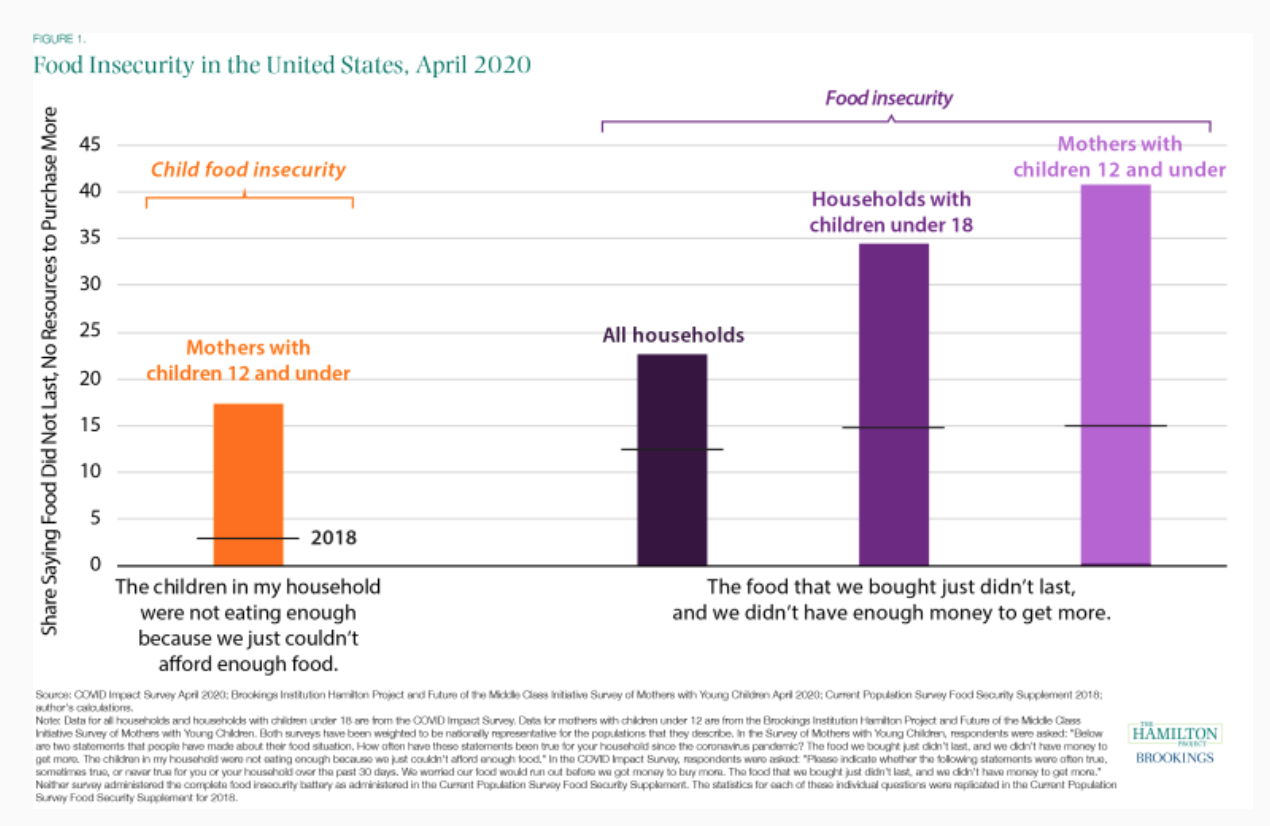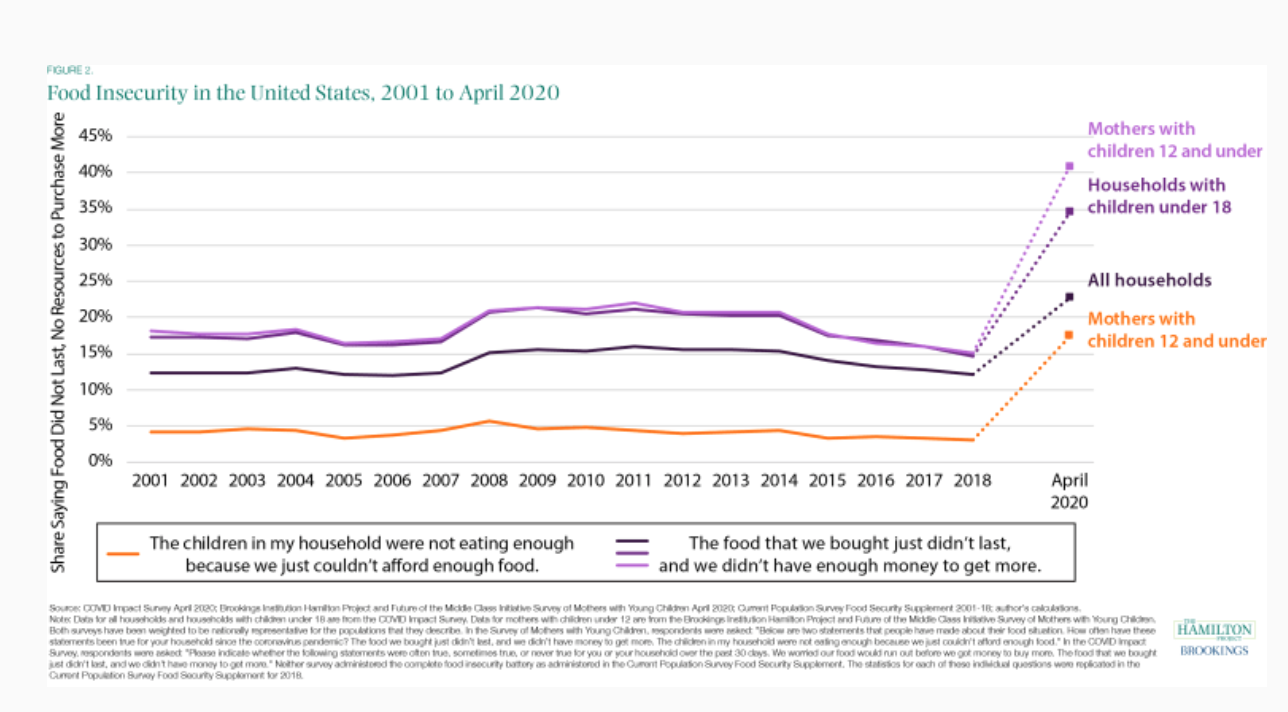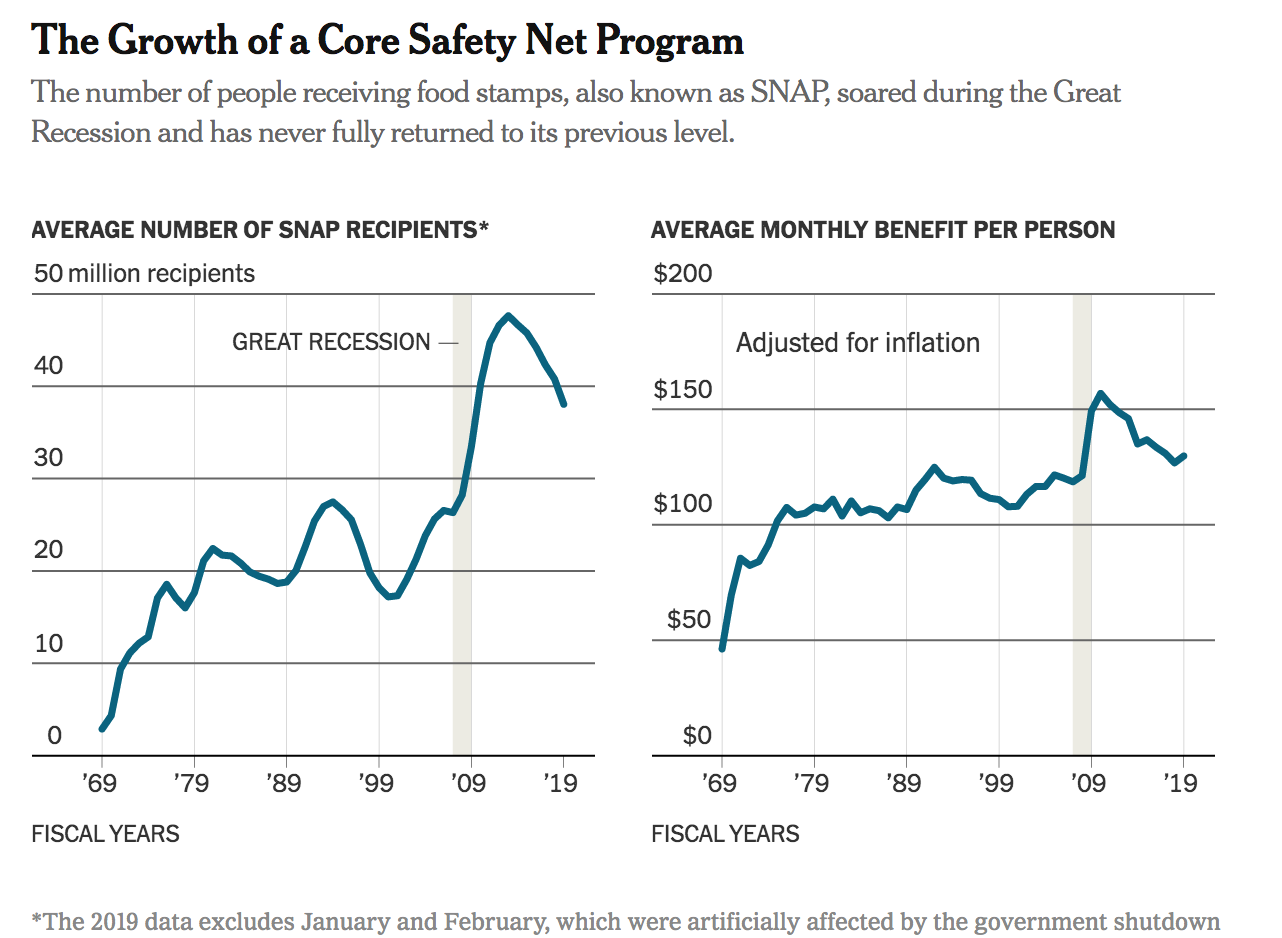Given the dramatic rise in unemployment, cuts in hours, and sharp decline in gig economy work, it isn’t surprising that hunger is becoming more common, particularly among families with children. Nearly half the US couldn’t withstand a $400 emergency, and most households that have taken hits are seeing bigger income losses than that. Only 29% of the unemployed got insurance payments in March, and those set to get paper stimulus checks could get them as late as August.
A new Brookings study, performed by Lauren Bauer based on a late April 2020 survey, gives a stark picture:

Look at the raw responses: 40% of the households with children don’t have enough food, and over 1/6 of the children under 12 aren’t being fed enough. Given the way the questions are phrased, children may be in even worse shape than these results suggest, since some respondents might not want to admit that their kids are going hungry; as we’ll see soon, Bauer sees this as the case when she compares these results to other survey data.
Compare the situation now to the minor blip during and shortly after the financial crisis:

And some families are suffering severe hunger. Bauer pointed out that 3.4% of the mothers said their under 12 year old children were “often” not eating enough since the start of the coronavirus responses due to lack of resources.
The USDA uses a different metric, “food insecurity” and typically finds food insecurity to be twice as high as the levels found when asking if families don’t have enough to eat. Because Bauer is using two different surveys, some of the comparisons are labored, but you can get the drift of the gist:
The Survey of Mothers with Young Children found that 40.9 percent of mothers with children ages 12 and under reported household food insecurity since the onset of the COVID-19 pandemic. This is higher than the rate reported by all respondents with children under twelve in the COVID Impact Survey (34.4 percent) but the same as women 18–59 living with a child 12 and under (39.2 percent.) In 2018, 15.1 percent of mothers with children ages 12 and under affirmatively answered this question in the FSS, slightly more than the 14.5 percent that were food insecure by the complete survey. The share of mothers with children 12 and under reporting that the food that they bought did not last has increased 170 percent.
Bauer recommends increasing the maximum SNAP benefits by at least 15% and the minimum by 50% as well as other measures like suspending work requirements for students and continuing the current work requirement suspension.
The New York Times is amplifying these findings and turning to the Congressional fight over whether to raise SNAP benefits. Note that the increase in benefits displayed in the chart below almost certainly explains why hunger didn’t rise meaningfully as a result of the financial crisis. And the fact that they’ve remained high confirms that this recovery wasn’t all it was cracked up to be:

Of course, the Republicans are spinning the data the other way. They contend fact that the level of SNAP benefits remained high even after unemployment rates fell is proof that the program is a big handout and too many people are getting bennies who don’t need them. Someone needs to pound into their heads what a living wage means and that you can cut the cake any way you want to – higher wages or more generous safety nets – but people need to eat. Or maybe not.
One of the reasons for the Brooking report focus on child hunger is that the Administration has set out to axe many of them from the program:
Mr. Trump and his congressional allies have agreed to only a short-term increase in food stamp benefits that omits the poorest recipients, including five million children.
From the New York Times reminds readers that attacking food stamps has been a two party affair:
Its current form dates to a 1977 compromise between two Senate lions, the liberal George McGovern and the conservative Bob Dole. But almost simultaneously Ronald Reagan added to a stream of racialized attacks on the program, invoking the image of a “strapping young buck” who used food stamps to buy steaks. As president, Reagan went on to enact large cuts.
After President Bill Clinton pledged to “end welfare” in the 1990s by restricting cash aid, conservatives sought to include big cuts in food stamps, which he resisted. The law he signed subjected cash aid to time limits and work requirements but allowed similar constraints on just one group of food stamp recipients — adults without minor children, roughly 10 percent of the caseload. (Other provisions disqualified many immigrants.)
Food stamps was also one of the few places where W lived up to some of his campaign branding:
His Republican successor, George W. Bush, called himself a “compassionate conservative” and promoted food stamps — partly to help people leaving cash welfare to work — and the caseloads grew by nearly two-thirds.
“I don’t see it as a welfare program,” said Eric M. Bost, Mr. Bush’s first food stamp administrator. “I see it as a nutritional assistance program. You can only use it to buy food.”
And even though the program rules are not generous, Trump has made a point of being Scrooge in Chief:
To qualify, a household must have an income of 130 percent of the poverty line or less, about $28,000 for three people. Before the pandemic, the average household had a total income of just over $10,000 and received a benefit of about $239 a month.
But Mr. Trump has done all he can to shrink the program. He sought budget cuts of 30 percent. He tried to replace part of the benefit with “Harvest Boxes” of cheaper commodities. He tried to reduce eligibility and expand work rules to a much larger share of the caseload….
In December, Mr. Trump issued a rule that made it harder for states to waive work mandates in areas of high unemployment….
A second target of administration ire is a policy that lets states expand eligibility by waiving certain limits on income and assets. About 40 states do so, although the budget center found more than 99 percent of benefits go to households with net incomes below the poverty line ($21,700 for a family of three).
Critics of the policy — “broad-based categorical eligibility” — say it encourages abuse by allowing people with significant savings to collect benefits. The Trump administration is seeking to eliminate it and has predicted that 3.1 million people would lose benefits, 8 percent of the caseload.
The lack of not just compassion, but a perception of the real stakes, is breathtaking. Shortly after the Tarhir Square uprising, Nomura published an analysis of food and cooking oil costs in various countries and estimate the proportion of families that could not longer afford them. My recollection is 40% was the level at which it was a safe bet that large scale riots would erupt. On current trajectories, it won’t be that long before the US gets there.


Depressing reading. It is hard to understand why those who have the most, begrudge resources for those who have little. The callous disregard of the consequences of such attitudes is hard to bear.
On an equally depressing note, Richard Murphy over in the UK has just published a 4000 word essay outlining what we will be facing if the government doesn’t shift its focus from propping up rentiers to bailing out SME’s and workers. It is sombre reading.
Scratch that last comment – I just scrolled down and Richard’s essay is on the list of articles.
It’s beyond maddening that the government is constantly adding new hurdles to basic assistance at the same time as contracts for N95 masks and other pandemic-related gear seem to be handed out to anyone sufficiently well-connected, even if they have no knowledge or ability to procure any medical supplies. Maybe we could train the out of work in the vagaries of federal procurement so they could get in on the action instead of being stuck on hold with the unemployment office.
– Governmental Poverty Response Flow Chart –
…IF election year, go to #1, otherwise see #2…
#1: Virtue signalling required?…: High-Optic Token Handouts to Select Individuals (poster child creation)
#2: No One Watching?…: Go Die.( we make lots more poor people all the time…)
Plus one. Any Rand would be proud.
“Given the dramatic rise in unemployment,…”
I wonder if the governments of states ordering people not to work had anything to do with that? Maybe we should classify all people as “essential” rather than label half non-essential.
I suggest you get up to speed on this topic. The problem is the virus, not the government, and other countries with more aggressive responses got it under control. For instance, Seoul is bigger than NYC, has at least as much use of public transportation, and has had only 2 deaths v. NYC’s 19,000 and rising.
People who are afraid of dying or getting debilitating damage if they survive are not going to be keen about traveling, going to bars, going to a salon, etc.
You might start here, for instance and then get back to us when you know what you are talking about:
https://www.nakedcapitalism.com/2020/05/the-false-dawn-of-ending-coronavirus-lockdowns.html
i was surprised at the NYT article linked…ususally don’t expect any more to see support for these things, there.
in that article “my” representative is quoted:
“…Rejecting what he called the Democrats’ narrative of “hardhearted Republicans,” he warned against tempting people to become dependent on government aid. “I don’t want to create a moral hazard for people to be on welfare.”
Conaway got his start as the Bush Crimenfamilia’s consiglieri.
I’ve spoken and argued with his people for years…even had the opportunity to b&tch him out, once(regarding auditing the Pentagram; one of his perennial word salads during campaigns).
He has exhibited no fears of Moral Hazard for the rich…
30+ million of my fellow americans are learning about just how screwed up, cruel and hateful our Poor People Programs really are.
For instance, regarding the Unemployment System(sic), that it is designed specifically….not to help people…but to root out “Fraud”….
They’re all like that: food stamps, medicaid, ssi, disability, help with the light bill.
the Default Assumption is that you’re trying to pull one over on them, and mooch off the government.
With that as a starting position, it is no wonder the help cannot get to where it needs to go.
You’re right of course, about the faux-fraud concerns. I’m sure they seem real to the people designing the programs though, since they spend every waking moment trying to pull one over on the people and mooching off the government. It only makes sense to them that everyone else is just like they are, and to plan accordingly.
It’s gaslighting all the way down.
I’ll take ‘The Financialization of Class Warfare’ for $2,000, Alex.
A big, perhaps almost the only reason is that the recipients are poor. and therefore powerless to defend themselves. It is easy to use political theater on them because they cannot fight back.
On the rates of hunger, it looks like it is starting to go into early Great Depression levels of hunger. If this does not change, I expect that a few examples of death by starvation to occur as happened in the first years of the Great Depression before the ramped up feeding programs of various government and private groups. Granted they were rare, but real enough and hunger means weakness and a reduced ability to fight off diseases.
What a world.
Excellent job, Yves. Well worth forwarding.
The reflexive vigilance of the Repubs on this, coldly poring over stats based on mothers reporting that their children are hungry, reeks of Dickensian sadism.
It is also the Democrats as they really do not do much except for some pro forma protests; considering the extent of the problem (every Bay Area county has at least five or six under supplied food banks plus soup kitchens as well) it would be real easy to get some hungry people who have been cut off or have had their funds cut to testify, or to use the many, many charities, volunteers, and government workers as well as the many studies over the decades as evidence. There are even conservatives, even hardliners, who support upping SNAP as eating is rather important and you can only buy food with it. They would find it easy to politically support SNAP if asked. There are also farmers and food sellers like Walmart who want to expand the program.
With all this political ammunition it would probably be easy to maintain or even greatly increase the program’s funding, but the Democratic leadership at least judging by their actions just don’t care.
Anecdote regarding elite fears of unemployment fraudsters: I’m currently drawing unemployment in NYS. Last time I called I counted all the times I was threatened. There were no less than seven (overt and implied) warnings against fraud, including one where the voice actor emphasizes the phrase “severe consequences” with a sharp tone. There is also an option to learn more about UI fraud if you’re especially interested. I wonder if selecting that option flags your account for review…
I estimate that at least a third of each call is spent listening to threats that you can’t jump past. The website has been useless for me due to an ID screw up in their end. Given how forked up the system has been and how many people have been trying to use it, these threats seem like a real drain on efficiency. Which is the point.
It’s about the extortion payday and all the politicians are in on it.
The media barons build the financial ghetto and buy control of the natural resources feeding it, private profit at social cost. Take your pick of landlords, say the One’s in Betsy’s backyard in Maine. Turner is worth many, many times what Gates is worth because electronic money is meaningless (or sunk cost asset inflationary) in the real world, which is why Gates is stuck on the speaking tour peddling snakeoil. But being the captain of the Titanic isn’t all it’s cracked up to be either.
might be a good time to get closer to the real food supply lines.
An additional weak link in our chain composed mostly of links so weakened that they are all about to break is climate change. The increasingly erratic climate compounds problems in which perishable produce is timed for a just-in-time food delivery system. My mangoes are ripening about six weeks early this year.
If hunger levels are high and americans have no savings and the government isnt able to provide basic unemployment insurance why do they keep voting for biden??
> My recollection is 40% was the level at which it was a safe bet that large scale riots would erupt.
When, over mead and weiqi with a trusted friend, I brought this up, he responded with a paper he saw that with unemployment at 33%, riots began. I backtracked from the Labor Force Participation Rate, etc, and ballparked we’re at 35% as of yesterday.
I also perambulated the thought, in the Viking way both sober and not, thar “permanently disqualifying” military service for being Covid-positive was a shot from the depths of the Pentagon, by somebody trying to be a decent human being. My friend knew lots of farmers growing up, was offered a spot on a Big-10 football team and talked about his father, who pushed military and manhood, and disappointment when he quit the team. There’s a Be A Man aspect I can’t quite ungenderfy, and it’s a shot at the cultural nads to being Permanently Disqualified from the opportunity.
So the memo will be certainly dialed back, but the message might resound in the rural no-mask communities that provide the bodies for the military machine. As a SecAg told Congress, iirc. And a Thank You for whoever put their careers on the line with the memo.
militarytimes.com/news/your-military/2020/05/06/coronavirus-survivors-banned-from-joining-the-military/